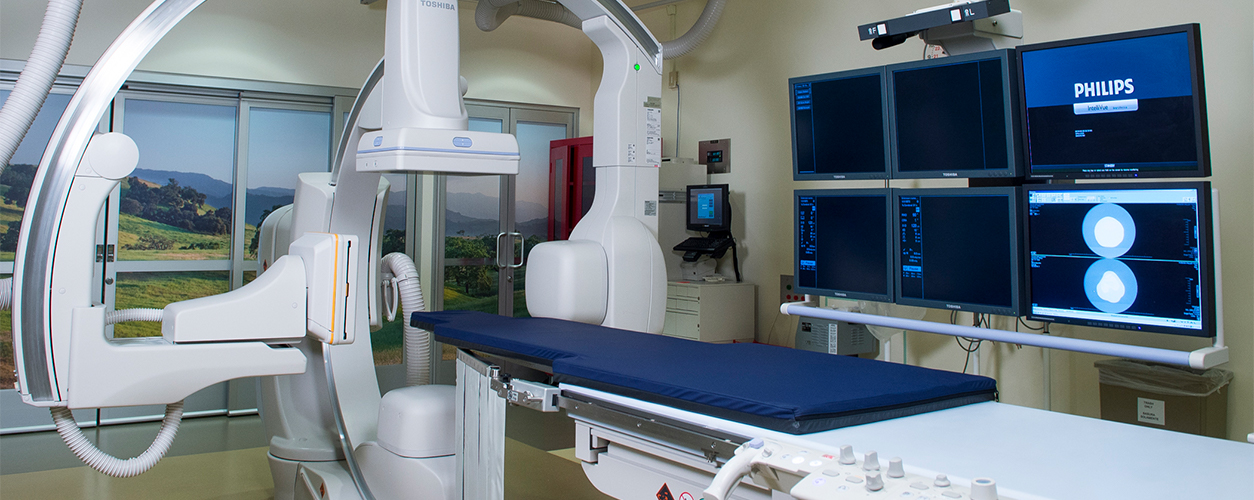
Interventional Radiology & Angiography
Treating Conditions Using Radiological Imaging
Interventional radiology is the subspecialty of radiology that treats Vascular diseases and other conditions using radiological imaging in combination with percutaneous treatment procedures. Percutaneous treatment procedures involve the insertion of needles or narrow tubes (catheters) into an affected vein, artery, organ or other body part via a small incision or needle puncture in the skin. The catheter or needle is guided into place and the procedure is performed.
Pomona Valley Hospital Medical Center provides comprehensive, State-of-the-art interventional radiology procedures including:
Arterial Stent placement: An arterial stent is a tiny cylindrical device that is positioned inside a diseased or collapsing artery to provide additional support.
Dialysis Shunt Evaluation: Radiologists at PVHMC are available to provide Full shunt evaluation and maintenance services.
Nephrostomy Tube Placement: Radiologists place a drainage tube in the Kidney to relieve pressure caused by blockage. They may also place a tube in the ureter to help urine flow from the kidney to the bladder.
Thrombolytic Therapy: Using catheters and radiology imaging techniques to administer special medication to dissolve dangerous blood clots.
Transjugular Intrahepatic Portosystemic Shunt (TIPS): A procedure that relieves bleeding of the liver caused by liver disease.
Interventional Lab
The chance of surviving a stroke can be increased if the victim gets help right away. PVHMC now has a new state-of-the-art interventional radiology suite, which will allow physicians to diagnose and treat stroke victims with minimally-invasive technology.
When every second is critical when treating stroke victims, the interventional lab allows us more flexibility and is a superior alternative that gives our patients a better chance of surviving. The interventional neuro-radiology lab offers our community access to the same cutting-edge technology, previously only available at the larger academic or regional medical centers located more than 30 miles away, without losing critical time in-transit.
With these advanced technical capabilities, PVHMC can use a team approach for diagnosis and treatment of a wide range of vascular disease stroke and conditions by being able to take images and do a procedure at the same time. By being able to complete procedures more quickly and comfortably, also improves the overall patient experience and outcomes. The lab includes advanced 3D imaging technology, which allows radiologists to quickly move through arteries, diagnose the exact amount of blockage and communicate to the physician the precise size and location of a stroke.
From prevention to treatment, PVHMC is committed to the continued investment in the health of our community. We are pleased to offer this life-saving treatment, we also encourage our community to continue taking steps that will reduce their risk of heart attack or stroke.
PVHMC is certified as a primary stroke center by the Joint Commission and has a comprehensive stroke rehabilitation program.
In addition to these procedures, PVHMC/s interventional radiologists Are experienced in performing angiograms and balloon angioplasties. The first is a diagnostic procedure that allows physicians to evaluate the condition of arteries by x-ray and contrast solution. The resultant images provide information that enables physicians to determine the most appropriate course of treatment for the patient. Balloon angio- plasty provides treatment for patients whose arteries are clogged. A catheter equipped with a tiny balloon is carefully positioned in the affected artery. The balloon is inflated which reduces blockage of the artery. The balloon and catheter are then removed.
Pomona Valley Hospital Medical Center
Department of Radiology
1798 North Garey Avenue
Pomona, CA 91767
909.865.9580
